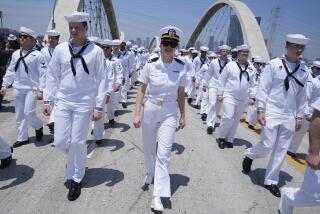Bay Area crowds see battleship Iowa off on final voyage
- Share via
It was a stirring sight in World War II: the biggest U.S. battleship ever built passing slowly beneath the Golden Gate Bridge and into the Pacific, bound for battle.
On Saturday, thousands witnessed the same historic passage as the Iowa was towed from San Francisco Bay on one last mission — a journey to Southern California and its permanent home as a floating museum on the San Pedro waterfront.
The 45,000-ton warship, a fixture in the U.S. mothball fleet for years, was to start its voyage May 20, but weather-wary planners delayed the trip because of predicted storms. Tall as a 15-story building and as long as three football fields, the Iowa passed under the bridge just after 3 p.m. and, tethered to the 7,200-horsepower ocean-going tug Warrior, headed down the coast.
Coincidentally, the 69-year-old ship’s stately passage occurred as tourists thronged San Francisco for Memorial Day and for a citywide celebration of the bridge’s 75th birthday.
“It’s so fitting that this great warship goes out for her last time on the bridge’s 75th anniversary,” said Bob Rogers, a spokesman for the Pacific Battleship Center, the nonprofit that is funding the ship’s move and transformation into a museum.
“So many battleships and destroyers left for the Pacific out of San Francisco Bay,” he said. “There were very emotional feelings as they passed under the bridge to go out and very happy feelings when they passed under it to return.”
On Saturday morning, crowds jamming a bay-front park saw a crew cast off the huge ropes that stretched between the Iowa and its temporary berth in Richmond, where the ship was undergoing renovation for the trip. The battleship gave three mighty blasts of its horn as tugboats slowly guided it half a mile into the water and maneuvered it 90 degrees toward the ocean — a task that took about an hour.
Stewart Munson of San Rafael was sitting in the weeds with his sketchbook, capturing an impression of the ship where he recently spent 32 hours as a volunteer chipping paint.
“I’m very sorry to see it leave,” he said, “but I know Los Angeles will be a good home for her.”
In the bay, tour boats and private vessels carried history buffs eager to glimpse the aged ship. Earlier in the week, operators of the Potomac —Franklin D. Roosevelt’s presidential yacht — anticipated guests lining up at the rails for a last-ever view of the Iowa going to sea.
“It’s a moment in history that won’t be repeated,” said Marti Burchell, director of the nonprofit association that charters the vessel.
Even after weather scuttled the Iowa’s departure last Sunday, the Potomac gave more than 100 tourists — many of them children and grandchildren of World War II veterans — an up-close-and-personal view of the battleship at it sat at its dock. They were serenaded by a Navy band aboard the SS Jeremiah O’Brien, another World War II vessel that had a load of Iowa-gazers out for a Champagne cruise.
Most of the battleship’s journey will be made 50 miles offshore, well beyond eyeshot of the coast but also beyond most vessels that could be jeopardized if violent seas cut the ship loose. The Iowa will be connected to the tug by a system of cables and chains a third of a mile long. Each link in the chain weighs 110 pounds, according to a spokesman for Crowley Maritime, the Warrior’s owner.
The trip will take about four days, depending on the weather, and can be tracked at https://www.pacificbattleship.com. Once the Iowa is anchored off the Southern California coast, divers will scrub its hull to remove any invasive species or contaminants. It is to anchor permanently at Berth 87 in San Pedro on June 9 and open as a museum on July 7.
Times photographer Don Bartletti contributed to this report.
More to Read
Sign up for Essential California
The most important California stories and recommendations in your inbox every morning.
You may occasionally receive promotional content from the Los Angeles Times.











